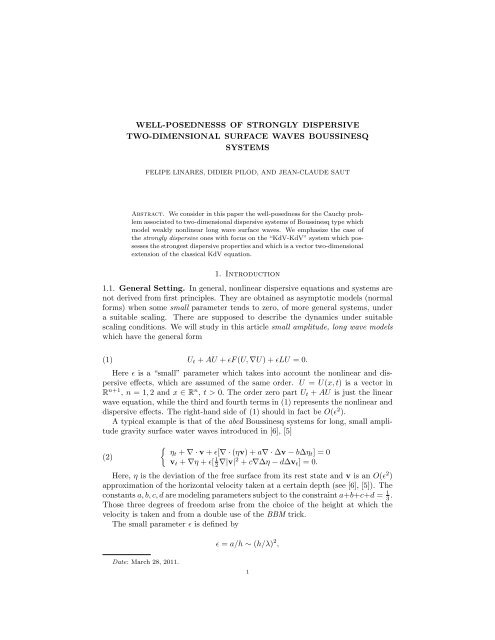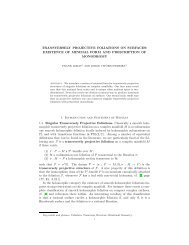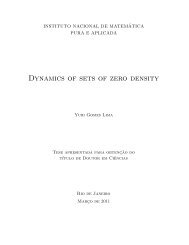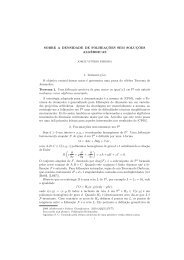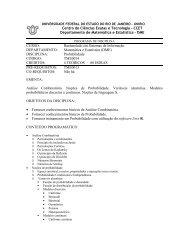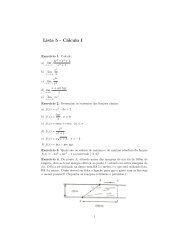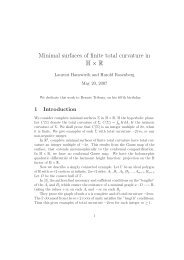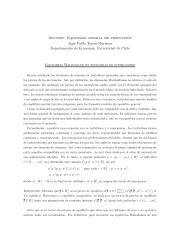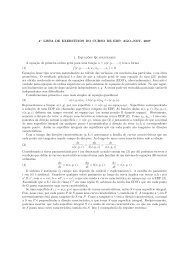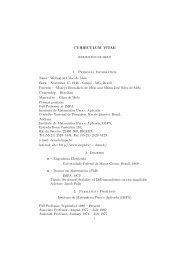Well-posednesss of strongly dispersive two-dimensional ... - IMPA
Well-posednesss of strongly dispersive two-dimensional ... - IMPA
Well-posednesss of strongly dispersive two-dimensional ... - IMPA
Create successful ePaper yourself
Turn your PDF publications into a flip-book with our unique Google optimized e-Paper software.
6 FELIPE LINARES, DIDIER PILOD, AND JEAN-CLAUDE SAUT[29] Appendix A in a slightly different context, a minor modification <strong>of</strong> Bourgain’smethod as used in [23] allows to solve the Cauchy problem for (5) for data inH s (R) × H s (R) with s > − 3 4. We refer to [8] for details. It is worth noticing thatin [8] the question <strong>of</strong> the dependence <strong>of</strong> the existence time with respect to ɛ is notconsidered.Coming back to the <strong>two</strong>-<strong>dimensional</strong> system, we will establish that the Cauchyproblem is locally well-posed for data in H s (R 2 ) × H s (R 2 ) 2 where s > 3 2 .Theorem 1. Let s > 3 2 and 0 < ɛ ≤ 1 be fixed. Then for any (η 0, v 0 ) ∈ H s (R 2 ) ×H s (R 2 ) 2 with curl v 0 = 0, there exist a positive time T = T (‖(η 0 , v 0 )‖ Hs ×(H s ) 2), aspace YT s ɛsuch that(6) Y s T ɛ↩→ C ( [0, T ɛ ] ; H s (R 2 ) × H s (R 2 ) 2) ,and a unique solution (η, v) to (3) in YT s ɛsatisfying (η, v) |t=0 = (η 0 , v 0 ), whereT ɛ = T ɛ − 1 2 .Moreover, for any T ′ ∈ (0, T ɛ ), there exists a neighborhood Ω s <strong>of</strong> (η 0 , v 0 ) inH s (R 2 ) × H s (R 2 ) 2 such that the flow map associated to (3) is smooth from Ω s intoYT s ′.Remark 1. Our pro<strong>of</strong> applies as well with minor modifications to Boussinesq systemswith b = d = 0 and a < 0, c < 0. While this case is excluded for systemsmodeling purely gravity waves, it may happen for capillary-gravity waves when thesurface tension parameter τ is large enough.Remark 2. It transpires from the pro<strong>of</strong> <strong>of</strong> Theorem 1 that the solution is uniformlybounded (with respect to ɛ) in the corresponding spaces on a time interval [0, T √ ɛ].The strategy is first to diagonalize the linear part <strong>of</strong> (3). We thus reduce theoriginal system to a nonlocal one. In particular, the nonlinear part involves orderzero pseudo-differential operators (in fact Riesz transforms). We then solve theunderlying Duhamel integral formulation by a fixed point argument in a ball <strong>of</strong>a Banach space constructed from the various <strong>dispersive</strong> estimates satisfied by thelinear part. Note that here, we are able to compute the dependence on ɛ <strong>of</strong> theconstants appearing in the linear estimates. This allows us to obtain an existenceresult in a time interval [0, T ] depending on ɛ, in our case T ∼ ɛ − 1 2 .We will thus proceed as follows. We first derive the Hamiltonian formulation <strong>of</strong>(3). We then perform the diagonalization and state the <strong>dispersive</strong> estimates whichare to be used in the fixed point argument. The maximal function and Strichartzestimates seem to be new. Finally, we solve the new system (10) which is equivalentto (3), assuming curl v 0 = 0.3.1. Hamiltonian structure. The system (3) can be rewritten on the form(7) ∂ t u + A ɛ u + ɛN (u) = 0,where⎛ ⎞ ⎛⎞η0 (1 + ɛ∆)∂ x1 (1 + ɛ∆)∂ x2u = ⎝v 1⎠ , A ɛ = ⎝(1 + ɛ∆)∂ x1 0 0 ⎠ ,v 2 (1 + ɛ∆)∂ x2 0 0
8 FELIPE LINARES, DIDIER PILOD, AND JEAN-CLAUDE SAUTThen, if we denote by ̂P the matrix <strong>of</strong> (E 0 , E 1 , E 2 ) in the canonical basis, we havethat⎛⎞⎛⎞0 1 −1⎜ ξ 2 ξ 1 ξ 1 ⎟̂P = ⎝ |ξ| |ξ| |ξ| ⎠ , and ̂P −1 = 1 0 2 ξ2|ξ|−2 ξ1|ξ|⎜ ξ⎝ 1 1 ξ 2 ⎟|ξ| |ξ| ⎠ .2−1and− ξ1|ξ|ξ 2|ξ|ξ 2|ξ|Therefore, the linear part <strong>of</strong> (7) is equivalent to ∂ t w + Dw = 0, where⎛ ⎞⎛w 0w = ⎝w 1⎠ = P −1 u, P −1 = 1 ⎝ 0 2iR ⎞2 −2iR 11 iR 1 iR 2⎠ ,2w 2 −1 iR 1 iR 2ξ 1|ξ|⎛⎞0 0 0D = ⎝0 i(1 + ɛ∆) √ −∆ 00 0 −i(1 + ɛ∆) √ ⎠ .−∆Next, we turn to the nonlinear part <strong>of</strong> (7). N (u) is given as function <strong>of</strong> w by⎛⎞∂x 1 ((w 1 − w 2 )(R 2 w 0 + R 1 (w 1 + w 2 ))) + ∂x 2 ((w 1 − w 2 )(−R 1 w 0 + R 2 (w 1 + w 2 )))⎝12 ∂ (x 1 (R2 w 0 + R 1 w 1 + R 1 w 2 ) 2 + (−R 1 w 0 + R 2 w 1 + R 2 w 2 ) 2) ⎠12 ∂ (x 2 (R2 w 0 + R 1 w 1 + R 1 w 2 ) 2 + (−R 1 w 0 + R 2 w 1 + R 2 w 2 ) 2) .Then, deduce, using the identities R 2 ∂ x1 = R 1 ∂ x2 and R 1 ∂ x1 + R 2 ∂ x2 = √ −∆,that⎛P −1 N (u) = 1 ⎝ 0⎞I + II ⎠ =: Ñ (w),2−I + IIwhere(8)andI = I(w 1 , w 2 ) =(w 1 − w 2 ) √ −∆(w 1 + w 2 ) + ∂ x1 (w 1 − w 2 )R 1 (w 1 + w 2 )+ ∂ x2 (w 1 − w 2 )R 2 (w 1 + w 2 ),(9) II = II(w 1 , w 2 ) := i √ −∆ ( (R 1 (w 1 + w 2 )) 2 + (R 2 (w 1 + w 2 )) 2) .Summarizing we have that (3) is equivalent to{∂t w(10)1 + i(1 + ɛ∆) √ −∆w 1 + (I + II)(w 1 , w 2 ) = 0∂ t w 2 − i(1 + ɛ∆) √ −∆w 2 + (−I + II)(w 1 , w 2 ) = 0 ,where I(w 1 , w 2 ) and II(w 1 , w 2 ) are defined in (8) and (9).Remark 3. Note that we use in our analysis that w 0 = 0. Indeed, the equation onw 0 is ∂ t w 0 = 0. Moreover,w 0 = 0 ⇐⇒ R 2 v 1 = R 1 v 2 ⇐⇒ curl v = 0.We observe that this condition is physically relevant. The Boussinesq systems derivedfrom the water waves equations, where the fluid is supposed to be irrotationaland v is an O(ɛ 2 ) approximation <strong>of</strong> the horizontal velocity at a certain depth whichis a gradient. Note also that since the equation for v writes ∂ t v = ∇F , the conditioncurlv = 0 is preserved by the evolution.ξ 2|ξ|
TWO-DIMENSIONAL SURFACE WAVES BOUSSINESQ SYSTEMS 9Now, to derive the smoothing effects associated to the linear part <strong>of</strong> (3), itsuffices to consider the linear system{ut ± L(11)ɛ u = 0,u(., 0) = u 0 ,where L ɛ = i(I + ɛ∆) √ −∆ = −iϕ ɛ (D), i.e. ϕ ɛ (ξ) = ɛ|ξ| 3 − |ξ|. In the sequel, wewill identify ϕ ɛ (ξ) = ϕ ɛ (|ξ|). Moreover, we will denote by U ɛ ± (t)u 0 the solution <strong>of</strong>(11), i.e.( ) ∨.(12) U ɛ ± (t)u 0 = e ±itϕɛ û 0The smoothing effects are <strong>of</strong> three different types.3.2.2. Dispersive smoothing estimates. We will use the results in [19] (see also thegeneral results in [25]) to deduce the following local smoothing estimates.Let { Q α denote a family <strong>of</strong> nonoverlapping cubes <strong>of</strong> unit size such that}α∈Z 2R 2 = ∪ Q α.α∈Z 2Theorem 2. Let T > 0 and ɛ > 0. Then, it holds that( ∫ ∫ T(13) sup ∣ P>ɛ − 1 D1 2 xU ɛ ± (t)u 0 (x) ∣ 2 dtdxα Q α0) 12where the implicit constant does not depend on ɛ and T . ɛ − 1 2 ‖u0 ‖ L 2 x,Pro<strong>of</strong>. Without loss <strong>of</strong> generality, we can assume that Q α = Q := {x : |x| < 1}.We fix a function η in C0 ∞ (R) such that 0 ≤ η ≤ 1, η ≡ 1 on [−1, 1] and supp η ⊂[0, 2]. Let us define η ɛ (x) = ɛ 1 2 η(ɛ 1 2 x). Then P ≤ɛ− 1 , respectively P 2 >ɛ − 2 1 denote theoperators defined by(14) P ≤ɛ− 1 u 0 = F −1( )η2 ɛ (| · |)û 0 and P >ɛ−2 1 = 1 − P ≤ɛ − 1 .2Observe that in the support <strong>of</strong> 1 − η ɛ (| · |), we have that |∇ϕ ɛ (ξ)| = 3ɛ|ξ| 2 − 1 > 0.Then it follows by using Theorem 4.1, formula (4.2), p 54-55 in [19] that∥∥D xU 1 ɛ ± (t)P >ɛ−2 1 u ( ∫∥|ξ| 2) 10 L 2 Q×[0,T ] |ξ|>ɛ − 1 2 3ɛ|ξ| 2 − 1 |û 0(ξ)| 2 2dξ(15)which concludes the pro<strong>of</strong> <strong>of</strong> Theorem 2. ɛ − 1 2 ‖u0 ‖ L 2 x,3.2.3. The maximal function estimate. We will prove our maximal function estimatein the n-<strong>dimensional</strong> case. In other words, we will consider the unitary groupU ± ɛ (t) = e ±itϕɛ(D) , where ϕ ɛ (ξ) = ϕ ɛ (|ξ|) = ɛ|ξ| 3 − |ξ| and ξ ∈ R n , for n ≥ 2. Let{Q α } α∈Z n denote the mesh <strong>of</strong> dyadic cubes <strong>of</strong> unit size. The main result <strong>of</strong> thissubsection reads as follows.Theorem 3. With the above notation, for any s > 3n 4, ɛ > 0 and T > 0 satisfyingɛT ≤ 1, it holds that( ∑ ∣(16)sup sup ∣U ±ɛ (t)u 0 (x) ∣ 2) 1 2 (1 + T n 4 − 1 4 )‖u0 ‖ H s,x∈Q αα∈Z n |t|≤Twhere the implicit constant does not depend on ɛ and T .□
10 FELIPE LINARES, DIDIER PILOD, AND JEAN-CLAUDE SAUTWe will only treat the case <strong>of</strong> U ɛ +, since the case <strong>of</strong> U ɛ − is similar. The pro<strong>of</strong> <strong>of</strong>Theorem 3 is based on the next lemma.Lemma 1. For k ∈ Z + , let ψ k ∈ C0 ∞ ([2 k−1 , 2 k+1 ]) be such that 0 ≤ ψ k ≤ 1. Thenfor ɛt ∈ (0, 2],∫(17)∣ e i(tϕɛ(ξ)+x.ξ) ψ k (|ξ|)dξ∣ ≤ cH k (|x|),R nwhere H k is decreasing and satisfies∫(18)H k (|x|)dx (1 + |t| n 2 − 1 3kn2 )2 2 ,R nand H k (r) ≤ c2 3kn2 for r ∈ (0, 10). Also, a similar result holds for ψ ∈ C0 ∞ ([−10, 10])with 2 3kn2 replaced by c. Observe that the implicit constant does not depend on ɛand t, but may depend on the dimension n.The following estimate, essentially proved in Proposition 2.6 <strong>of</strong> [20], will beuseful.Proposition 1. For k ∈ Z + , ɛt ∈ (0, 2], r ∈ R and ψ k as in Lemma 1, define(19) I k (t, r) =∫ +∞0e i(ɛts3 +sr) ψ k (s)ds.Then⎧⎨ c2 k for |r| ≤ 1(20) |I k (t, r)| ≤ F k (r) = c2 k 2 r⎩− 1 2 for 1 ≤ |r| ≤ c2 2kcr −N for |r| > c2 2kfor any N ∈ Z + .Moreover, it is known (see [32] for example) that the Fourier transform <strong>of</strong> aradial function f(|x|) = f(s) is still radial and is given by(21) ̂f(r) = ̂f(|ξ|) = r− n−22∫ ∞where J m is the Bessel function, defined by(r/2) m(22) J m (r) =Γ(m + 1/2)π 1 2∫ 1−10f(s)J n−2 (rs)s n 2 ds,2e irs (1 − s 2 ) m− 1 2 ds, for m > −12 .Next, we list some properties <strong>of</strong> the Bessel functions (see [32], [22], [16] and thereferences therein).Lemma 2. It holds that(23) J m (r) =r→0O(r m ),(24) J m (r) =r→+∞ e−irfor any N ∈ Z + , andN∑j=0(25) r − n−2α m,j r −(j+ 1 2 ) + e ir2 J n−22N∑j=0(r) = c n R ( e ir h(r) ) ,˜α m,j r −(j+ 1 2 ) + O(r −(N+ 3 2 ) ),
TWO-DIMENSIONAL SURFACE WAVES BOUSSINESQ SYSTEMS 11where h is a smooth function satisfying(26)∣ ∂kr h(r) ∣ ≤ ck (1 + r) − n−12 −k ,for any k ∈ Z + .Pro<strong>of</strong> <strong>of</strong> Lemma 1. By using (21), it follows that(27)∫I k (t, r) := e i(tϕɛ(ξ)+x.ξ) ψ k (|ξ|)dξ = r − n−22R n 0∫ +∞e it(ɛs3−s) ψ k (s)J n−2 (rs)s n 2 ds,2where r = |x| ∈ [0, +∞) and ɛt ∈ [0, 2].When 0 ≤ |r − t| ≤ 1 or 0 ≤ r ≤ 1, it follows from (23) (or (25)–(26)) that(28)∣ Ik (t, r) ∣ ∫ +∞ ψ k (s)s n−1 ds = c2 nk .0In the case r > 1 and |r − t| > 1, we substitute J n−2 by the right-hand side2<strong>of</strong> (24) in (27) and evaluate successively each term <strong>of</strong> the sum and the remainder.Here we consider only the most difficult case, when ˜α m,j = 0. Then, the j th termhas the formso thatI k,j (t, r) := r − n−22∫ +∞∣ Ik,j (t, r) ∣ ≤ r− n−22 (2 k r) −(j+ 1 2 ) 2 k n 20e i(t(ɛs3 −s)+sr) ψ k (s)(rs) −(j+ 1 2 ) s n 2 ds,∣∫ +∞0e i(tɛs3 +s(r−t) ∣ ˜ψk (s)ds∣,where ˜ψ k is another function satisfying ˜ψ k ∈ C ∞ 0 ([2 k−1 , 2 k+1 ]) and 0 ≤ ˜ψ k ≤ 1.Therefore, we deduce from Proposition 1 that(29)∣ Ik,j (t, r) ∣ ∣ { 2k( n 2 −j) r −( n 2 − 1 2 +j) |r − t| − 1 2 for |r − t| ∈ [1, c2 2k ]2 k( n 2 −j− 1 2 ) r −( n 2 − 1 2 +j) |r − t| −m for |r − t| > c2 2k ,for any m ∈ Z + . Next, we fix N = N(n) > n−12and bound the remainderas follows(30)R k (t, r) := r − n−22∫ +∞0e i(tϕɛ(s)+sr) ψ k (s)(rs) −(N+ 3 2 ) s n 2 ds∣ Rk (t, r) ∣ ∣ 2k( n 2 −N− 1 2 ) r −( n 2 +N+ 1 2 ) r −m ,with m > n.Therefore, if we define⎧⎨ 2 kn for |x| ≤ 1 or ||x| − t| ≤ 1∑ NH k (|x|) = j=0⎩2k( n 2 −j) |x| −( n 2 − 1 2 +j) ||x| − t| − 1 2 for 1 ≤ ||x| − t| ≤ c2 2k2 k( n 2 − 1 2 ) ||x| − t| −m for ||x| − t| > c2 2k ,andH k (|x|) = H k (|x|) +2 kn(1 + |x|) m
12 FELIPE LINARES, DIDIER PILOD, AND JEAN-CLAUDE SAUTit follows from (27)–(30) that ∣ ∣I k (t, |x|) ∣ ≤ cH k (|x|) and a simple computation leadsto∫H k (|x|)dx ≤ c2 kn + c2 kn 2R n ∫r n 2 − 1 2 |r − t|− 1 2 dr1≤|r−t|≤c2 2k≤ c2 3kn2 (1 + |t|n2 − 1 2 ),which concludes the pro<strong>of</strong> <strong>of</strong> Lemma 1.Finally, at this point, the pro<strong>of</strong> <strong>of</strong> Theorem 3 follows closely the argument <strong>of</strong>Kenig, Ponce and Vega in the case <strong>of</strong> the Schrödinger equation in Theorem 3.2 <strong>of</strong>[22]. Therefore, we will omit it.3.2.4. Strichartz estimates. Strichartz estimates for unitary groups <strong>of</strong> the forme itφ(D) in R n , n ≥ 2, were derived in the case where φ is an elliptic polynomialby Kenig, Ponce and Vega [19] and in the case where φ is a general polynomial inR 2 by Ben-Artzi, Koch and Saut [3]. When the phase function φ is a radial (nonhomogeneous)function and its derivative does not vanish, some techniques wererecently developed by Cho and Ozawa [12] and Guo, Peng and Wang [16].In the sequel, we will use the techniques developed in [16], based on the onesused in [19] and on the representation <strong>of</strong> the Fourier transform <strong>of</strong> a radial functionin terms <strong>of</strong> the Bessel function (see formula (21)), to prove Strichartz estimatesassociated to the unitary groups U ɛ± defined in (12). However, in our case, we donot need to perform a dyadic decomposition in frequencies.Theorem 4. Let 0 < ɛ ≤ 1, T > 0 and 0 ≤ α < 1 2. Then, it holds that(31) ‖D α x U ± ɛ u 0 ‖ LqαT L ∞ x ɛ−κα ‖u 0 ‖ L 2,for all u 0 ∈ L 2 (R 2 ), where the implicit constant is independent <strong>of</strong> ɛ and T , q α isthe root <strong>of</strong> the polynomialsatisfying q α > 2 and κ α = 1 2 + α 2 − 14q α.3q 2 − 2(7 − 2α)q + 12 = 0,Remark 4. When α = 0, then q = 7+√ 133= 7 2 + and κ = 1 2 − 1 4q = 3 7+. On theother hand, we have that lim α→ 1 q α = 2 and lim2 α→ 1 κ α = 5 2 8For sake <strong>of</strong> simplicity, we will fix U ɛ = U ɛ+ in the rest <strong>of</strong> this subsection. First,we derive the following decay estimate for the solution to the linear problem (11).Proposition 2. Let 0 < ɛ ≤ 1 and 0 ≤ β ≤ 1. Then, it holds that(32) ‖D β xU ɛ (t)u 0 ‖ L ∞ x k β,ɛ (t)‖u 0 ‖ L 1,for all t ∈ R, where k β,ɛ is given by{(ɛt)(33) k β,ɛ (t) =− 2+β3 if t ≤ θɛ 1 2ɛ − 3 4 − β 2 t − 1 2 if t ≥ θɛ 1 2and θ is any positive constant independent <strong>of</strong> ɛ.The pro<strong>of</strong> <strong>of</strong> Proposition 2 is based on formula (21), Lemma 2 and Van derCorput’s lemma:,□
TWO-DIMENSIONAL SURFACE WAVES BOUSSINESQ SYSTEMS 13Lemma 3. Suppose that f is a real valued C 2 -function defined in [a, b] such that|f ′′ (ξ)| > 1 for any ξ ∈ [a, b]. Then∫ b∣ e iλf(ξ) ψ(ξ)dξ∣ |λ| − ( 12 ‖ψ‖L ∞ + ‖ψ ′ ‖ L 1),awhere the implicit constant does not depend on a and b.Pro<strong>of</strong> <strong>of</strong> Proposition 2. First observe that(34) ‖D β xU ɛ (t)u 0 ‖ L ∞ x≤ ∥ ∥ ( | · | β e −itϕɛ) ∨∥∥L∞ x‖u 0 ‖ L 1.On the other hand, formulas (21) and (25) imply that(35)(|ξ| β e −itϕɛ) ∫ +∞∨(x) = s β e it(ɛs3−s) J 0 (rs)sds=0∫ +∞0= I β (r) + II β (r)s β e it(ɛs3 −s) e irs h(rs)sds +∫ +∞0s β e it(ɛs3 −s) e −irs h(rs)sdswhere r = |x|.For sake <strong>of</strong> simplicity, we will assume that t ≥ 0 and only deal with II β since I βcan be handled by similar techniques. We change variables u = (ɛt) 1 3 s and deducethat(36) II β (r) = (ɛt) − ( 2+β r )3 Aβ ,(ɛt) 1 3whereA β (r) =∫ +∞the phase function f r (u) is given byTherefore(37) supr≥00e ifr(u) h(ru)u β+1 du,f r (u) = u 3 − (r + α)u, and α = t 2 3 ɛ− 1 3 .∣ Aβ (r) ∣ β max{1, α 2 + 1 β4 } = max{1, t 3 + 1 6 ɛ− β 6 − 1 12 }, ∀ β ∈ [0, 1],would imply formula (32).To prove (37), we introduce the smooth real-values functions (ψ 1 , ψ 2 ) ∈ C0∞ ×C ∞such that 0 ≤ ψ 1 , ψ 2 ≤ 1, ψ 1 (u) + ψ 2 (u) = 1,supp ψ 1 ⊂ { u : |3u 2 − (r + α)| ≤ r + α }2andψ 2 = 0 in { u : |3u 2 − (r + α)| ≤ r + α }.3It follows that(38)∣ Aβ (r) ∣ ∣ ≤ ∣A 1β (r) ∣ ∣ + ∣A 2β (r) ∣ ,where∫ +∞A j β (r) = e ifr(u) h(ru)u β+1 ψ j (u)du, j ∈ {1, 2}.0First, we deal with A 2 β . Observe that we can restrict the oscillatory integralin the range u ∈ [1, +∞], since otherwise when u ∈ [0, 1], the estimate is trivial.
14 FELIPE LINARES, DIDIER PILOD, AND JEAN-CLAUDE SAUTMoreover, we deduce from the triangle inequality that in the support <strong>of</strong> ψ 2 , thederivative <strong>of</strong> the phase function satisfies |f r(u)| ′ = |3u 2 − (r + α)| > 1 6 (u2 + (r + α)).Then, we obtain integrating by parts that1A 2 β(r) == i∫ +∞1∫ +∞11 d (eif ) r(u)if r(u)′ h(ru)u β+1 ψ 2 (u)dudue ifr(u) d ( h(ru)u β+1 ψ 2 (u))du f r(u)′ du.Therefore, it follows from (26) that(39)∫ +∞ (|A 2 ru β+1u β+2β(r)| +(u 2 + (r + α))(1 + ru) 3 2 (u 2 + (r + α)) 2 (1 + ru) 1 2)du 1.Note that the implicit constant does not depend on r, ɛ or t.Next we turn to A 1 β . In the support <strong>of</strong> ψ 1, we have u ∼ (r + α) 1 2 , so that|f ′′r (u)| = 6u (r + α) 1 2 . Thus, it follows from Van der Corput’s lemma that|A 1 1(β(r)| ‖h(r·)(·) β+1 ψ(r + α) 1 1 ‖ L ∞ + ‖ d (h(r·)(·) β+1 )ψ 1 ‖L 1)4du(40)(r + α) 1 2 (1+β) max{1, α β(r + α) 1 4 (1 + r(r + α) 1 2 ) 1 2 + 1 4 }.2Finally, we deduce formula (37) combining (38)–(40), which concludes the pro<strong>of</strong><strong>of</strong> Proposition 2.□We are now in position to give a pro<strong>of</strong> <strong>of</strong> Theorem 4.Pro<strong>of</strong> <strong>of</strong> Theorem 4. Fix 0 ≤ α < 1 2 , β = 2α ∈ [0, 1), κ = κ α, q = q α and q ′ itsconjugate exponent, i.e. 1 q + 1 q= 1. We first observe by using a P. Tomas’ duality′argument (see for example [26]) that estimate (31) is equivalent to(41)∥∫ +∞−∞D β xU ɛ (t − t ′ )g(·, t ′ )dt ′∥ ∥Lqt L∞ x ɛ −2κ ‖g‖ Lq ′ ,tL1 xfor all g ∈ L q′ (R; L 1 (R 2 )).Next we prove estimate (41). It follows from Minkowski’s inequality and estimate(32) that(42)∥∫ +∞−∞D β xU ɛ (t − t ′ )g(·, t ′ )dt ′∥ ∥L ∞ x k β,ɛ ∗ ‖g(·)‖ L 1 x(t) := J β,ɛ (t),where k β,ɛ is defined in (33). We will denote ϕ(t) = ‖g(·, t)‖ L 1 x. Then we dividethe kernel k β,ɛ in <strong>two</strong> parts, k β,ɛ = k 0 β,ɛ + k∞ β,ɛ , whereso thatk 0 β,ɛ(t) = (ɛt) − 2+β3 χ{|t|≤θɛ 12 }and k ∞ β,ɛ(t) = ɛ − 3 4 − β 2 t− 1 2 χ{|t|≥θɛ 12 },(43) J β,ɛ (t) = J 0 β,ɛ(t) + J ∞ β,ɛ(t),where J 0 β,ɛ , respectively J ∞ β,ɛ, is the convolution operator associated to the kernelk 0 β,ɛ , respectively k∞ β,ɛ .
TWO-DIMENSIONAL SURFACE WAVES BOUSSINESQ SYSTEMS 15To estimate Jβ,ɛ 0 , we observe that∫Rk 0 β,ɛ(t)dt = 2∫ θɛ120(ɛt) − 2+β3 dt = cɛ1+β2 θ1−β3 ,since 0 ≤ β < 1. Therefore, it follows from Theorem 2 in Chapter III <strong>of</strong> [31] that(44) |J 0 β,ɛ(t)| ɛ 1+β2 θ1−β3 Mϕ(t),where M denotes the Hardy-Littlewood maximal function. On the other hand,Young’s theorem implies that( ∫ ) 1q(45) |Jβ,ɛ(t)| ∞ ≤ t − q 2 dt ‖ϕ‖|t|≥θɛ 1 L q ′ = β cɛ−(1+ 2 − 12q ) θ 1 q − 1 2 ‖ϕ‖L q ′ ,2since q > 2. Observe that 1 + β 2 − 1 2q > 1+β2. Thus, we deduce gathering (43)–(46)that(46) |J β,ɛ (t)| ɛ −(1+ β 2 − 12q )( θ 1 q − 1 2 ‖ϕ‖L q ′ + θ 1−β3 Mϕ(t)).Now, we choose θ = θ(t) to minimize the term on the right-hand side <strong>of</strong> (46), whichis to sayThis implies together with (46) thatθ(t) 5 6 − β 3 − 1 q = ‖ϕ‖L q ′ Mϕ(t)−1 .(47) |J β,ɛ (t)| ɛ −(1+ β 2 − 12q ) ‖ϕ‖ γ L q′ Mϕ(t)1−γ ,where γ =(1−β)2q5q−2βq−6. Then it follows that(48) ‖J β,ɛ ‖ L q ɛ −(1+ β 2 − 12q ) ‖ϕ‖ γ Lq′ ‖Mϕ‖1−γ .L (1−γ)qMoreover, observe that(1 − γ)q = q ′ ⇔ 3q 2 − 2(7 − β)q + 12 = 0.Finally, we conclude from the fact the maximal function is continuous in L q′ that(49) ‖J β,ɛ ‖ L q ɛ −(1+ β 2 − 12q ) ‖ϕ‖ L q ′ ,which concludes the pro<strong>of</strong> <strong>of</strong> Theorem 4.3.3. The nonlinear Cauchy problem. The objective <strong>of</strong> this subsection is toprove the following result.Theorem 5. Let s > 3 2 and 0 < ɛ ≤ 1 be fixed. Then for any (w0 1, w2) 0 ∈ H s (R 2 ) ×H s (R 2 ), there exist a positive time T = T (‖(w1, 0 w2)‖ 0 Hs ×H s), a space Xs T ɛsuchthat(50) X s T ɛ↩→ C ( [0, T ɛ ] ; H s (R 2 ) × H s (R 2 ) ) ,and a unique solution (w 1 , w 2 ) to (10) in X s T ɛsatisfying (w 1 , w 2 ) |t=0 = (w 0 1, w 0 2),where T ɛ = T ɛ − 1 2 .Moreover, for any T ′ ∈ (0, T ɛ ), there exists a neighborhood Ω s <strong>of</strong> (w 0 1, w 0 2) inH s (R 2 ) × H s (R 2 ) such that the flow map associated to (10) is smooth from Ω s intoX s T ′.First, we list some well-known properties <strong>of</strong> the Riesz transforms.□
TWO-DIMENSIONAL SURFACE WAVES BOUSSINESQ SYSTEMS 17We will show that, for adequate T and a, the map (F + , F − ) is a contraction in aclosed ball XT 2 (a) in X2 T <strong>of</strong> radius a > 0 and centered at the origin.Using the integral equation (54), Minkowski’s integral inequality, the linear estimates(13), (16) and (31) with α = 0 and α = 1 − γ, and the fact that the Riesztransforms are unitary operators in H s , we deduce that(55)4∑λ j (T F + (w 1 , w 2 ) ) +j=14∑j=1λ j T∫T ‖(w1, 0 w2)‖ 0 Hs ×H s + ɛ0(F − (w 1 , w 2 ) )(‖I(w1 , w 2 )(t)‖ H s x+ ‖II(w 1 , w 2 )(t))‖ H s x)dt.According to formulas (8) and (9), the nonlinearities I(w 1 , w 2 ) and II(w 1 , w 2 )contain terms <strong>of</strong> the three following types: w j Dxw 1 k , ∂ xl w j R l w k and Dx(R 1 l w j R m w k )for j, k, l, m = 1, 2. For sake <strong>of</strong> simplicity, we only will present the computationsfor a nonlinear term <strong>of</strong> the first kind, since the other ones can be handled by similararguments. In other words, we have to estimate the term ɛ ∫ T0 ‖w jDxw 1 k ‖ H s xdt asa function <strong>of</strong> the norms defined in (3.3). By the definition <strong>of</strong> the Sobolev spaceH s (R 2 ), we have that∫ T∫ T∫ T(56) ɛ ‖w j Dxw 1 k ‖ H s xdt ɛ ‖w j Dxw 1 k ‖ L 2 xdt + ɛ ‖Dx( s wj D 1 )xw k ‖L 2 xdt.000First, we use Hölder’s inequality and the Sobolev embedding H s (R 2 ) ↩→ L ∞ (R 2 )to estimate the first term on the right-hand side <strong>of</strong> (56) as(57)∫ Tɛ ‖w j Dxw 1 k ‖ L 2 xdt ≤ ɛT ‖w j ‖ L ∞T L ∞‖D1 x xw k ‖ L ∞T L 2 x0≤ ɛT λ 1 T (w j )λ 1 T (w k ).To treat the second term appearing on the right-hand side <strong>of</strong> (56), we observefrom (52) that D s x = D γ xR 1 ∂ x1 + D γ xR 2 ∂ x2 . Therefore, it follows from (51) that(58)∫ Tɛ ‖Dx( s wj D 1 )xw k ‖L 2 xdt0≤ ɛ ∑ ∫ T‖D γ (x ∂xl w j D 1 )xw k ‖L 2 xdt + ɛ ∑ ∫ T‖Dx( γ wj ∂ xl D 1 )xw k ‖L 2 xdt.0l=1,20l=1,2Then, we deduce from the fractional Leibniz’ rule (53) that(59)ɛ∫ T0‖Dx( γ ∂xl w j Dxw 1 )k ‖L 2 xdt ≤ ɛ 4 7 − T 5 7 + ɛ 3 7 + ‖∂ xl w j ‖ 7 + L 2TL∞ x‖Dx1+γ w k ‖ L ∞T L 2 x+ ɛ 4 7 − T 5 7 + ɛ 3 7 + ‖Dxw 1 k ‖ 7 + L 2‖∂ xl Dxw γ j ‖ L ∞T L 2TL∞ xx≤ ɛ 4 7 − T 5 7 +( λ 2 T (w j )λ 1 T (w k ) + λ 2 T (w k )λ 1 T (w j ) ) .
18 FELIPE LINARES, DIDIER PILOD, AND JEAN-CLAUDE SAUTOn the other hand, by using again Leibniz’ rule and Hölder’s inequality, weobserve that(60)ɛ∫ T0≤ ɛ‖D γ x(wj ∂ xl D 1 xw k)‖L 2 xdt∫ T0‖D γ xw j ‖ L 2 x‖∂ xl D 1 xw k ‖ L ∞ x∫ Tdt + ɛ0‖w j ∂ xl Dx1+γ w k ‖ L 2 xdt.We deal with the first term on the right-hand side <strong>of</strong> (60). We deduce by usingHölder’s inequality in time that(61)ɛ∫ T0‖Dxw γ j ‖ L 2 x‖∂ xl Dxw 1 k ‖ L ∞ xdt≤ ɛ 1−κα T 1q α ′ ‖Dxw γ j ‖ L ∞T L 2 x ɛκα ‖∂ xl Dxw 1 k ‖ Lqα≤ ɛ 1−κα T 1q ′ α λ T 1 (w j )λ T 3 (w k ),where q α ′ is the conjugate exponent to q α .Finally, to estimate the second term on the right-hand side <strong>of</strong> (60), we observethat(62)∫ Tɛ0≤ ɛ‖w j ∂ xl Dx1+γ w k ‖ L 2 xdt∫ T0‖w j P ≤ɛ− 1 2 ∂ x lD 1+γx w k ‖ L 2 xdt +∫ T0TL ∞ x‖w j P >ɛ−2 1 ∂ x lDx1+γ w k ‖ L 2 xdt.On the one hand, we use the Sobolev embedding H s (R 2 ) ↩→ L ∞ (R 2 ), since s > 1,to obtain that(63)ɛ∫ T0‖w j P ≤ɛ− 1 ∂ x2 lDx 1+γ w k ‖ L 2 xdt ≤ ɛT ‖w j ‖ L ∞T,x‖P ≤ɛ− 1 ∂ x2 lDx1+γ w k ‖ L ∞T L 2 x≤ ɛT ‖w j ‖ L ∞T Hx sɛ− 1 2 ‖D1+γx w k ‖ L ∞T L 2 x≤ ɛ 1 2 T λ1T (w j )λ 1 T (w k ).On the other hand, we deduce from Hölder’s inequality that(64)ɛ(65)∫ T0‖w j P >ɛ−2 1 ∂ x lDx1+γ w k ‖ L 2 xdt≤ ɛT 1 2≤ ɛT 1 2( ∑α∈Z 2 ∫Q α×[0,T ]( ∑α∈Z 2 ‖w j ‖ 2 L ∞ Qα×[0,T ]≤ ɛ 3 8 T12 λ5T (w j )λ 4 T (w k ).) 1|w j P >ɛ− 1 ∂ x2 lDx1+γ w k | 2 2dxdtThus, it follows gathering (55)–(62) that∥ ( F + (w 1 , w 2 ),F − (w 1 , w 2 ) )∥ ∥X 2T≤ c‖(w 0 1, w 0 2)‖ H 2 ×H 2) 12+ c ( ɛ 4 7 − T 5 7 + + ɛ 1−κα T 1q ′ α + ɛ 1 2 T + ɛ3sup ‖P >ɛ− 1 ∂ xα∈Z 2 2 lDx 1+γ w k ‖ L 2Qα×[0,T ]18 T 2)‖(w1 , w 2 )‖ 2 X,T2
TWO-DIMENSIONAL SURFACE WAVES BOUSSINESQ SYSTEMS 19and similarly,∥ ( F + (w 1 , w 2 ), F − (w 1 , w 2 ) ) − ( F + ( ˜w 1 , ˜w 2 ), F − ( ˜w 1 , ˜w 2 ) )∥ ∥X 2T≤ c ( ɛ 4 7 − T 5 7 + + ɛ 1−κα T 1q α ′ + ɛ 1 3 1 )(66)2 T + ɛ 8 T 2Observe that× ( ‖(w 1 , w 2 )‖ X 2T+ ‖( ˜w 1 , ˜w 2 )‖ X 2T)‖(w1 , w 2 ) − ( ˜w 1 , ˜w 2 )‖ X 2T.c ( ɛ 4 7 − T 5 7 + + ɛ 1−κα T 1q ′ α + ɛ 1 2 T + ɛ38 T12) 1,since T ɛ − 1 2 . Therefore, we deduce by choosinga = 2c‖(w 0 1, w 0 2)‖ H2 ×H 2 and T ∼ ɛ− 1 2that (F + , F − ) defines a contraction in the space XT 2 (a), which concludes the pro<strong>of</strong><strong>of</strong> Proposition 5 by the Picard fixed point theorem.□4. Other <strong>strongly</strong> <strong>dispersive</strong> Boussinesq systemsOther <strong>two</strong>-<strong>dimensional</strong> Boussinesq systems can be classified according to theorder <strong>of</strong> the eigenvalues <strong>of</strong> the dispersion matrix (see Introduction). As we alreadymentioned, when b, d > 0, the well-posedness on time scales <strong>of</strong> order 1/ √ ɛ has beenestablished in [15] for initial data in low order Sobolev spaces and on time interval<strong>of</strong> order 1/ɛ in [27] for smooth initial data (with loss <strong>of</strong> derivatives). We thusrestrict ourselves to the case where at least one <strong>of</strong> the coefficients b or d vanishes,emphasizing the strongest <strong>dispersive</strong> case corresponding to eigenvalues <strong>of</strong> order 2(the so-called “Schrödinger” type systems) where a < 0 and c < 0.The local well posedness for some <strong>of</strong> those systems has been established in the<strong>two</strong>-<strong>dimensional</strong> case by Cung The Anh [13], but without looking for the dependence<strong>of</strong> the existence time with respect to ɛ. Note however that the pro<strong>of</strong> given in[13] for the case where d = 0 (Theorem 3.5) does not seem to be correct.We will complete the analysis, in particular by checking the ɛ dependence. Itturns out that when d > 0, one can establish the local well-posedness <strong>of</strong> Boussinesq“Schrödinger” type systems on time intervals <strong>of</strong> order 1/ √ ɛ by elementary energymethods, in relatively low order Sobolev spaces.We first state a useful lemma.Lemma 5. Let s ≥ 3/2. Then there exists C > 0 such that for any v ∈ H s+1 (R 2 )and η ∈ H s (R 2 ),(67) |(Λ s ∇ · (ηv), Λ s η)| ≤ C‖v‖ H s+1‖η‖ 2 H s.The pro<strong>of</strong> <strong>of</strong> this lemma is based on the following commutator estimate obtainedby Ponce in Lemma 2.3 <strong>of</strong> [28].Lemma 6. If s > 1 and 1 < p < ∞, then(68) ‖[Λ s ; f]g‖ L p ≤ C ( ‖∇f‖ L p 1 ‖Λ s−1 g‖ L p 2 + ‖Λ s f‖ L p 3 ‖g‖ L p 4),where p 1 , p 4 ∈ (1, +∞] such that1p 1+ 1 p 2= 1 p 3+ 1 p 4= 1 p .
20 FELIPE LINARES, DIDIER PILOD, AND JEAN-CLAUDE SAUTPro<strong>of</strong> <strong>of</strong> Lemma 5. Fix s ≥ 3 2. First observe that(69) (Λ s ∇ · (ηv), Λ s η) = (Λ s ∂ x1 (ηv 1 ), Λ s η) + (Λ s ∂ x2 (ηv 2 ), Λ s η).Moreover, we can rewrite the terms appearing on the right-hand side <strong>of</strong> (69) as(70) (Λ s ∂ xj (ηv j ), Λ s η)= (Λ s (η∂ xj v j ), Λ s η)+([Λ s , v j ]∂ xj η, Λ s η)+(v j Λ s ∂ xj η, Λ s η).We use Lemma 4 and the Sobolev embedding H α (R 2 ) ↩→ L ∞ (R 2 ), for α > 1, toestimate the first term on the right-hand side <strong>of</strong> (70) as∣(71)∣(Λ s (η∂ xj v j ), Λ s η) ∣ ≤ C‖v‖ H s+1‖η‖ 2 H s.On the other hand, it follows from Lemma 6 with p 1 = ∞, p 2 = 2, p 3 = p 4 = 4,and the Sobolev embedding H 1 2 (R 2 ) ↩→ L 4 (R 2 ) that∣ ([Λ s , v j ]∂ xj η, Λ s η) ∣ ∣(72)≤ C ( ‖∇v j ‖ L ∞‖Λ s−1 ∂ xj η‖ L 2 + ‖Λ s v j ‖ L 4‖∂ xj η‖ L 4)‖Λ s η‖ L 2≤ C‖v‖ H s+1‖η‖ 2 H s.Finally, we have integrating by parts that(v j Λ s ∂ xj η, , Λ s η) = − 1 2 (∂ x jv j Λ s η, Λ s η),which implies by Hölder’s inequality and the Sobolev embedding H α (R 2 ) ↩→ L ∞ (R 2 ),for α > 1, that(73)∣ (vj Λ s ∂ xj η, Λ s η) ∣ ≤ C‖v‖H s+1‖η‖ 2 H s.Therefore, estimate (67) is deduced gathering (69)–(73).4.1. Schrödinger type Boussinesq systems when d > 0. As already mentioned,attention is focused here in systems where the eigenvalues λ ± (ξ) are <strong>of</strong>order 2. Because <strong>of</strong> the constraint on a, b, c, d the only possibilities are a < 0, c < 0,b = 0, d > 0 or a < 0, c < 0, b > 0, d = 0. 4 We will study here the first case andthus consider the systems(74){ηt + ∇ · v + ɛ[∇ · (ηv) + a∇ · ∆v] = 0v t + ∇η + ɛ[ 1 2 ∇|v|2 + c∇∆η − d∆v t ] = 0,where a < 0, c < 0, d > 0.Those systems are called in [7] “Benjamin-Ono type systems” since the dispersionmatrix has, in the one-<strong>dimensional</strong> case and when ɛ = 1, eigenvalues equal to±(( acd ) 1 2 k|k| + r(k)) where r(k) is 0( 1|k|) as k → ∞.In the <strong>two</strong>-<strong>dimensional</strong> case, the dispersion matrix in Fourier variables reads⎛0 ξ 1 (1 − ɛa|ξ| 2 ) ξ 2 (1 − ɛa|ξ| 2 ⎞)ξ 1(1−ɛc|ξ| 2 )1+ɛd|ξ|0 0Â(ξ 1 , ξ 2 ) = i ⎜2 ⎟⎝⎠ .ξ 2(1−ɛc|ξ| 2 )1+ɛd|ξ|0 02The corresponding nonzero eigenvalues are4 When surface tension is large enough so that τ > 1/3, we have the admissible system a = b =d = 0, c = τ − 1/3 but we will note consider it here.□
TWO-DIMENSIONAL SURFACE WAVES BOUSSINESQ SYSTEMS 23Energy estimates in the case a ≠ c. We apply the operator Λ s to both equations <strong>of</strong>(74), multiply the first one by Λ s η + cɛ∆Λ s η, take the scalar product <strong>of</strong> the secondone by Λ s v + aɛ∆Λ s v, integrate and sum to obtain that(79)1 d [‖η‖22 dt H s − cɛ‖∇η‖ 2 H + s ‖v‖2 H + (d − s a)ɛ‖∇v‖2 H − s adɛ2 ‖∆v‖ 2 ]H s∫∫∫= ∇ · Λ s vΛ s η + cɛ ∇ · Λ s v∆Λ s η + ∇Λ s η · Λ s v∫∫∫+ aɛ ∇Λ s η · ∆Λ s v + aɛ ∇ · ∆Λ s vΛ s η + acɛ 2 ∇ · ∆Λ s v∆Λ s η∫∫∫+ cɛ ∇∆Λ s η · Λ s v + acɛ 2 ∇∆Λ s η · ∆Λ s v + ɛ Λ s ∇ · (ηv)Λ s η∫+ ɛ 2 c Λ s ∇ · (ηv)∆Λ s η + ɛ ∫∫Λ s ∇(|v| 2 ) · Λ s v + ɛ2 aΛ s ∇(|v| 2 ) · ∆Λ s v22∑12:= J l .l=1Now, observe integrating by parts that J 1 + J 3 = J 2 + J 7 = J 4 + J 5 = J 6 + J 8 = 0.Moreover, we deduce from Lemma 5 that(80) |J 9 | ≤ ɛ‖v‖ H s+1‖η‖ 2 H s,and(81) |J 10 | ≤ ɛ 2 ‖v‖ H s+2‖η‖ 2 H s+1.On the other hand, it follows integrating by parts and using Lemma 6 that(82) |J 11 | ≤ ɛ‖v‖ H s+1‖v‖ 2 H s,and(83) |J 12 | ≤ ɛ 2 ‖v‖ H s+2‖v‖ 2 H s+1.Finally, let define Y byY (t) = ‖η‖ 2 H s − c‖∇η‖2 H s + ‖v‖2 H s + (d − a)ɛ‖∇v‖2 H s − adɛ2 ‖∆v‖ 2 H s.Then it follows gathering (79)–(83) thatY ′ (t) ≤ Cɛ 1/2 Y (t) 3/2 ,which in turn implies an a uniform in ɛ priori bound on a time interval [0, T √ ɛ].4.2. Schrödinger type Boussinesq systems when d = 0 with curl free velocityfield. We thus consider the case a < 0, c < 0, b > 0, d = 0.(84){ηt + ∇ · v + ɛ[∇ · (ηv) + a∇ · ∆v − b∆η t ] = 0v t + ∇η + ɛ[ 1 2 ∇|v|2 + c∇∆η] = 0.We will here restrict the velocity v to irrotational motions, a situation which, aswe already indicated is relevant since the variable v in the Boussinesq systems iscurlfree up to a O(ɛ 2 ) term. Note also that the curlfree condition is preserved bythe evolution <strong>of</strong> (84). When v is curlfree, the term 1 2 ∇|v|2 in the second equation <strong>of</strong>(84) writes as <strong>two</strong> transport equations namely (v·∇v 1 , v·∇v 2 ) T where v = (v 1 , v 2 ) T .This will permit to perform energy estimates on v.□
24 FELIPE LINARES, DIDIER PILOD, AND JEAN-CLAUDE SAUTTheorem 7. Let s > 2 and 0 < ɛ ≤ 1 be given.(i) Assume that a = c. Then, for every (η 0 , v 0 ) ∈ H s+1 (R 2 ) × H s (R 2 ) 2 withcurl v 0 = 0 there exist T = T (||η 0 || H s+1, ||v 0 || H s) and a unique solution(η, v) ∈ C([0, T ɛ ]; H s+1 (R 2 )) × C([0, T ɛ ]; H s (R 2 ) 2 ),where T ɛ = T ɛ −1/2 , <strong>of</strong> (74) with initial data (η 0 , v 0 ), which is uniformly boundedon [0, T ɛ ].(ii) Assume that a ≠ c. Then, for every (η 0 , v 0 ) ∈ H s+2 (R 2 ) × H s+1 (R 2 ) 2 withcurl v 0 = 0 there exist T = T (||η 0 || H s+2, ||v 0 || H s+1) and a unique solution(η, v) ∈ C([0, T ɛ ]; H s+2 (R 2 )) × C([0, T ɛ ]; H s+1 (R 2 ) 2 ),where T ɛ = T ɛ −1/2 <strong>of</strong> (74) with initial data (η 0 , v 0 ) which is uniformly bounded on[0, T ɛ ].The pro<strong>of</strong> <strong>of</strong> Theorem 7 is very similar to that <strong>of</strong> Theorem 6 and we only sketchit. We will use the following estimate.Lemma 7. Let s > 2 and v ∈ H s (R 2 ) such that curl v = 0. Then∫∣ Λ s ∇|v| 2 · Λ s v∣ ≤ C‖v‖ 3 H s.R 2Pro<strong>of</strong>. Let v = (v 1 , v 2 ) T . Then ∂ x1 v 2 = ∂ x2 v 1 and12 ∇|v|2 = (v 1 ∂ x1 v 1 + v 2 ∂ x2 v 1 , v 1 ∂ x1 v 2 + v 2 ∂ x2 v 2 ) T .The estimate then follows immediately from integration by parts, the Kato-Poncecommutator lemma and the embedding H s−1 (R 2 ) ↩→ L ∞ (R 2 ).□Pro<strong>of</strong> <strong>of</strong> Theorem 7. (i) Uniqueness. Again we consider ɛ = 1. Let (η 1 , v 1 ), (η 2 , v 2 )<strong>two</strong> solutions and let N = η 1 − η 2 , V = v 1 − v 2 . We have therefore{Nt + ∇ · V + ɛ[∇ · (Nv(85)1 + η 2 V) + a∇ · ∆V − b∆N t ] = 0V t + ∇N + ɛ[ 1 2 ∇(V · (v 1 + v 2 )) + c∇∆N] = 0.We multiply the first equation by −cN, take scalar product <strong>of</strong> the second one by−aV, integrate and sum. One obtains after integrations by parts∫1 d[|c|N 2 + |a||V| 2 + |c|b|∇N| 2 ]2 dt R 2≤ C(‖v 1 ‖ L ∞, ‖η 2 ‖ L ∞, ‖∇v 1 ‖ L ∞, ‖∇v 2 ‖ L ∞)[‖N‖ 2 L + 2 ‖∇N‖2 L + 2 ‖V‖2 L 2],and the result follows from Gronwall’s lemma.(ii) Existence. We just indicate how to obtain the energy estimates in the casea = c. We apply the operator Λ s to both equations <strong>of</strong> (74), multiply the first oneby Λ s η, take the scalar product <strong>of</strong> the second one by Λ s v, integrate and sum to getusing Kato-Ponce Lemma and Lemma 7(86)ddt [‖Λs η‖ 2 L + 2 ‖Λs v‖ 2 L + 2 ɛb‖∇Λs η‖ 2 L 2]∫≤ Cɛ∣Λ s ∇ · (ηv)Λ s η + Λ s ∇|v| 2 · Λ s v∣R 2≤ Cɛ ( ‖∇v‖ L ∞‖Λ s η‖ 2 L 2 + ‖v‖3 H s ),
TWO-DIMENSIONAL SURFACE WAVES BOUSSINESQ SYSTEMS 25from which one obtain the expected a priori uniform estimate on a time interval[0, T/ √ ɛ].When a ≠ c one has to modify the pro<strong>of</strong> as in Theorem 6.□5. Final commentsTo keep this paper short and to maintain a certain unity, we have refrain hereto consider the other Boussinesq systems, which have eigenvalues λ ± <strong>of</strong> order 1 orless. For instance the cases a = c = b = 0, d = 1/3 or a = c = d = 0, b = 1/3are version <strong>of</strong> Boussinesq original system. The former case has been studied in theone-<strong>dimensional</strong> case by Schonbek [30] and Amick [2] who obtained global wellposednessby viewing the system as a (<strong>dispersive</strong>) perturbation <strong>of</strong> the Saint-Venant(shallow-water) hyperbolic system.In both cases, no results seem to be available in <strong>two</strong>-dimensions.Acknowledgements. The Authors were partially supported by the Brazilian-Frenchprogram in mathematics. J.-C. S. acknowledges support from the project ANR-07-BLAN-0250 <strong>of</strong> the Agence Nationale de la Recherche. F. L. was partially supportedby CNPq and FAPERJ/Brazil.References[1] B. Alvarez-Samaniego and D. Lannes, Large time existence for 3D water-waves andasymptotics, Inventiones Math., 171 (2008), 485–541.[2] C.J. Amick, Regularity and uniqueness <strong>of</strong> solutions <strong>of</strong> the Boussinesq system <strong>of</strong> equations,J. Diff. Eq., 54 (1984), 231–247.[3] M. Ben-Artzi, H. Koch and J.-C. Saut, Dispersion estimates for third order equations in<strong>two</strong> dimensions, Comm. Part. Diff. Eq. 28, no. 11–12 (2003), 1943–1974.[4] J. Bergh and J. Löfström , Interpolation Spaces, an Introduction, Springer-Verlag Berlin,1976.[5] J. L. Bona, T. Colin and D. Lannes, Long-wave approximation for water waves, Arch.Ration. Mech. Anal., 178 (2005), 373–410.[6] J. L. Bona, M. Chen and J.-C. Saut, Boussinesq equations and other systems for smallamplitudelong waves in nonlinear <strong>dispersive</strong> media I : Derivation and the linear theory, J.Nonlinear Sci., 12 (2002), 283–318.[7] J. L. Bona, M. Chen and J.-C. Saut, Boussinesq equations and other systems for smallamplitudelong waves in nonlinear <strong>dispersive</strong> media. II : The nonlinear theory, Nonlinearity,17 (2004), 925–952.[8] J. L Bona, Z. Grujic and H. Kalisch, A KdV -type Boussinesq system : from energy levelto analytic spaces, Disc. Cont. Dyn. Syst., 26, no. 2 (2010), 1121–1139.[9] J. L. Bona, D. Lannes, and J.-C. Saut, Asymptotic models for internal waves, J. Math.Pures Appl., 89 (2008), 538-566.[10] J. V. Boussinesq, Théorie des ondes et des remous qui se propagent le long d’un canalrectangulaire horizontal en communiquant au liquide contenu dans ce canal des vitesses sensiblementpareilles de la surface au fond, J. Math. Pures Appl., 17 (1872), 55–108.[11] W. Craig, P. Guyenne, and H. Kalisch, Hamiltonian long-wave expansions for free surfacesand interfaces, Comm. Pure. Appl. Math., 58 (2005), 1587–1641.[12] Y. Cho and T. Ozawa, On small amplitude solutions to the generalized Boussinesq equations,Disc. Cont. Dyn. Syst., 17 (2007), 691–711[13] Cung The Anh, On the Boussinesq/Full dispersion and Boussinesq/Boussinesq systems forinternal waves, Nonlinear Analysis, 72, no. 1 (2010), 409–429.[14] P. Daripa and R.K.Dash, A class <strong>of</strong> model equations for bi-directional propagation <strong>of</strong>capillary-gravity waves, Int. J. Eng. Sc., 41 (2003), 201–218.[15] V. Dougalis, D. Mitsotakis and J.-C. Saut, On some Boussinesq systems in <strong>two</strong> space dimensions: theory and Numerical Analysis, ESAIM : Mathematical Modelling and NumericalAnalysis, 41, no. 5, (2007), 825–854.
26 FELIPE LINARES, DIDIER PILOD, AND JEAN-CLAUDE SAUT[16] Z. Guo, L. Peng and B. Wang, Decay estimates for a class <strong>of</strong> waves equations, J. Funct.Anal., 254 (2008), 1642–1660.[17] P. Grisvard, Quelques propriétés des espaces de Sobolev, utiles dans l’étude des équationsde Navier-Stokes, Exposé 4 in “Problèmes d’évolution non linéaires”, Séminaire de Nice 1974–1975.[18] T. Kato and G. Ponce, Commutator estimates and the Euler and Navier-Stokes equations,Comm. Pure Appl Math., 41 (1988), 891–907.[19] C. E. Kenig, G. Ponce and L. Vega, Oscillatory integrals and regularity <strong>of</strong> <strong>dispersive</strong>equations, Indiana Univ. Math. J., 40 (1991), 33–69.[20] C. E. Kenig, G. Ponce and L. Vega, <strong>Well</strong>-posedness <strong>of</strong> the initial-value problem for theKorteweg-de Vries equation, J. Amer. Math. Soc., 4 (1991), 323–347.[21] C. E. Kenig, G. Ponce and L. Vega, <strong>Well</strong>-posedness and scattering results for the generalizedKorteweg-de Vries equation, Comm. Pure Appl. Math., 46 (1993), 527–620.[22] C. E. Kenig, G. Ponce and L. Vega, Small solutions to nonlinear Schrödinger equations,Ann. Inst. Henri Poincaré, 10 (1993), 255–288.[23] C. E. Kenig, G. Ponce and L. Vega, A bilinear estimate with application to the KdVequation, J. Amer. math. Soc., 9 (1996), 573–603.[24] C. E. Kenig, G. Ponce and L. Vega, Smoothing effects and local existence theory forgeneralized nonlinear Schrödinger equations, Inventiones Math., 134 (1998), 489–545.[25] H. Koch and J.-C. Saut, Local smoothing and local solvability for third order <strong>dispersive</strong>equations, SIAM J. Math. Anal., 38, no. 5, (2007), 1528–1541.[26] F. Linares and G. Ponce, Introduction to Nonlinear Dispersive Equations, Universitext,Springer, New York, 2009.[27] M. Ming, J.-C. Saut and P. Zhang, Long-time existence <strong>of</strong> solutions to Boussinesq systems,2011, submitted.[28] G. Ponce, Smoothing properties <strong>of</strong> solutions to the Benjamin-Ono equation, Lect. Note PureAppl. Math., 122, Dekher, New York, (1990), 667–679.[29] J.-C. Saut and N. Tzvetkov, On a model for the oblique interaction <strong>of</strong> internal gravitywaves, Math. Model. Numer. Anal., 34 (2000), 501–523.[30] M.E. Schonbek, Existence <strong>of</strong> solutions for the Boussinesq system <strong>of</strong> equations, J. Diff. Eq.,42 (1981), 325–352.[31] E. M. Stein, Singular integrals and differentiability properties <strong>of</strong> functions, Princeton MathematicalSeries, No. 30 Princeton University Press, Princeton, N.J., 1970[32] E. M. Stein and G. Weiss, Introduction to Fourier Analysis in Euclidian Spaces, PrincetonUniversity Press, Princeton, N.J., 1971.<strong>IMPA</strong>, Estrada Dona Castorina 110, Rio de Janeiro 22460-320, RJ BrasilE-mail address: linares@impa.brInstituto de Matemática, UFRJ, Caixa Postal 68530 CEP 21941-97, Rio de Janeiro,RJ BrasilE-mail address: didier@im.ufrj.br, pilod@impa.frLaboratoire de Mathématiques, UMR 8628,, Université Paris-Sud et CNRS,, 91405Orsay, FranceE-mail address: jean-claude.saut@math.u-psud.fr


